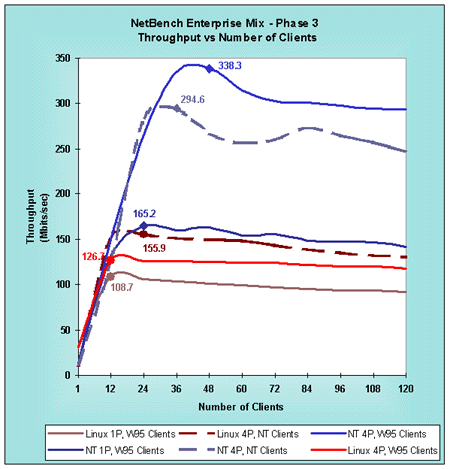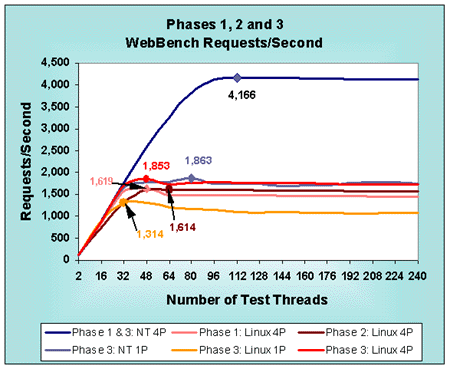
Open Benchmark
Phase 3
Windows NT Server 4.0 and Red Hat Linux 6.0
By Bruce Weiner
June 30,1999
Phase 3 Results
In Phase 3 of the Open Benchmark both Red Hat and Microsoft were free to use the latest software available and to make other configuration changes to the same Dell PowerEdge 6300/400 server used in Phases 1 and 2. Also, we tested both one- and four-processor configurations of the Dell server.
For Phase 3 Mindcraft used the same version of Windows NT Server 4.0 as in Phases 1 and 2. Red Hat chose to use Red Hat Linux 6.0 upgraded to the 2.2.10 kernel. See the Products Tested section below for other software, hardware and configuration changes.
The other significant change in Phase 3 was the use of both Windows 95 and Windows NT NetBench clients for the file-server tests.
File-Server Performance
Figure 1 shows the file-server performance we measured and the scaling between one- and four-processor configurations. Linux file-server performance on a four-processor system increases by 43% over a one-processor system. Windows NT Server, on the other hand, improves performance on a four-processor system by 105% over a one-processor system.
Figure 1: File Server Performance in Phase 3
(larger numbers are better)

Figure 1 shows that even the one-processor configuration running Windows NT Server is a faster file server than any of the Linux configurations. Table 1 summarizes the Windows NT Server speed advantage over Linux.
| # of Processors | Client Type | Windows NT Is Faster Than Linux By |
| 1 | Windows 95 | 1.5 times |
| 4 | Windows NT | 1.9 times |
| 4 | Windows 95 | 2.7 times |
Web-Server Performance
Figure 2 shows the Web-server performance for all of the phases. It shows that Red Hat was able to achieve 14% better performance in Phase 3 than in Phase 2. This was accomplished by using Linux 2.2.10 and different tuning for Apache, including static file caching. See the Products Tested section below for the details.
The Web-server tests show that Windows NT Server is 2.2 times faster than Linux 2.2.10/Apache 1.3.6 on a four-processor server and 1.4 times faster on a one-processor server.
Figure 2: Web Server Performance in Phases 1, 2 and 3
(larger numbers are better)

The performance scaling differences between Linux and Windows NT Server are even more pronounced for Web servers. Linux increases four-processor system performance by 42% over a single processor system. This compares to the 124% performance scaling improvement Windows NT Server demonstrates.
Performance Analysis
File Server Performance Analysis
If you have not already read the Looking at NetBench Results in the Phase 1 and 2 document, it may help you understand this analysis. The supporting details for Figure 1 are in the NetBench Configuration and Results part of this white paper.
The Windows NT Server 4.0 file-server peak performance increased between Phase 1 and Phase 3 primarily because we partitioned the RAID into four 7 GB partitions. This greatly reduced contention for the critical log file resource of the NT File System. Partitioning makes sense in real-world situations because it allows for more efficient system administration.
As a result of the partitioning, the four-processor Windows NT file-server performance increased over that in Phase 1 by about 9% with Windows 95 clients. When we switched to Windows NT clients, Windows NT Server turned in 294.6 Mbits/second of throughput, about 13% slower than with Windows 95 clients. Nevertheless, Windows NT Server still outperformed Linux/Samba by 1.9 times when both were tested using Windows NT clients.
The Red Hat engineers made several significant server configuration changes in addition to the Linux upgrade including:
The four-processor Linux/Samba test results using Windows 95 clients show that these configuration changes made no performance difference when compared to Phase 2. Thus, the Linux/Samba performance bottleneck is somewhere other than the disk subsystem. We believe the major reasons for the poor Linux/Samba performance are:
The shapes of the performance curves for both Windows NT Server 4.0 and Linux/Samba indicate that we reached peak performance and went beyond it. Performance for both Windows NT Server 4.0 and Linux/Samba degrades slowly as the load is increased past the peak performance load. So both systems should deliver predictable performance even under overload conditions.
Web-Server Performance Analysis
If you have not already read the Looking at WebBench Results in the Phase 1 and 2 document, it may help you understand this analysis.
We used the standard WebBench zd_static_v20.tst test suite, modified to increase the number of test threads to 240 (120 system with 2 threads each) for Phase 3.
The supporting details for Figure 2 are in the WebBench Configuration and Results part of this white paper.
The Linux/Apache configuration changes in Phases 3 improved the four-processor performance by 15% over Phase 2. We believe that most of this improvement came from memory mapping (caching) the data files in Apache and from the Apache "top fuel" patch.
Mindcraft used its Phase 1 four-processor Windows NT WebBench results instead of re-running the test for Phase 3. Figure 2 shows the Windows NT one-processor Web server performance matches that of the Linux four-processor configuration.
Products Tested
We used the same Dell PowerEdge 6300/400 server that was used in Phases 1 and 2.
Software Products and Tuning
Windows NT Server 4.0 File-Server Configuration
We tested using Windows NT Server 4.0 Enterprise Edition with Service Pack 4 installed. We made the following configuration and tuning changes:
Windows NT Server 4.0 Web-Server Configuration
Linux 2.2.10 Configuration
The Red Hat engineers started with Red Hat Linux 6.0 and upgraded it to the Linux 2.2.10 kernel. They also made the following configuration and tuning changes:
We have included a separate Web page with all of the Linux configuration files Red Hat used.
Samba 2.0.3 Configuration
We have included a separate Web page with the Samba configuration files Red Hat used.
Apache 1.3.6 Configuration
We have included a separate Web page with the Apache configuration files Red Hat used.
The Test Lab
We used the same test lab configuration for Phase 3 that we used for Phases 1 and 2. The only change made was to run Windows NT Workstation 4.0 on the clients for the appropriate NetBench tests.
NOTICE:
The information in this publication is subject to change without notice.
MINDCRAFT, INC. SHALL NOT BE LIABLE FOR ERRORS OR OMISSIONS CONTAINED HEREIN, NOR FOR INCIDENTAL OR CONSEQUENTIAL DAMAGES RESULTING FROM THE FURNISHING, PERFORMANCE, OR USE OF THIS MATERIAL.
This publication does not constitute an endorsement of the product or products that were tested. This test is not a determination of product quality or correctness, nor does it ensure compliance with any federal, state or local requirements.
Product and corporate names mentioned herein are trademarks and/or registered trademarks of their respective companies.
Copyright © 1999 Mindcraft, Inc.